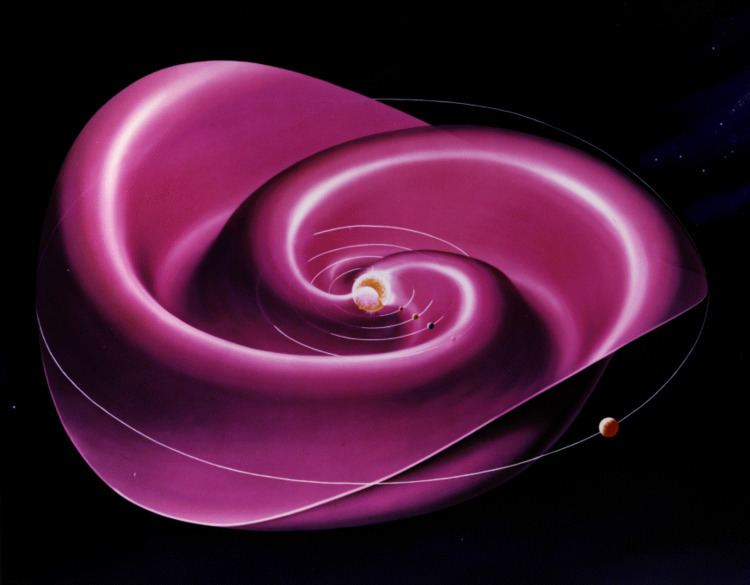 | ||
The heliospheric current sheet is the surface within the Solar System where the polarity of the Sun's magnetic field changes from north to south. This field extends throughout the Sun's equatorial plane in the heliosphere. The shape of the current sheet results from the influence of the Sun's rotating magnetic field on the plasma in the interplanetary medium (Solar Wind). A small electrical current flows within the sheet, about 10−10 A/m². The thickness of the current sheet is about 10,000 km near the orbit of the Earth.
Contents
The underlying magnetic field is called the interplanetary magnetic field, and the resulting electric current forms part of the heliospheric current circuit. The heliospheric current sheet is also sometimes called the interplanetary current sheet.
Ballerina's skirt shape
As the Sun rotates, its magnetic field twists into a Parker spiral, a form of an Archimedean spiral, as it extends through the solar system. This phenomenon is named after Eugene Parker's work: he predicted the solar wind and many of its associated phenomena in the 1950s. The spiral nature of the heliospheric magnetic field had been noted earlier by Hannes Alfvén, based on the structure of comet tails.
The influence of this spiral-shaped magnetic field on the interplanetary medium (solar wind) creates the largest structure in the Solar System, the heliospheric current sheet. Parker's spiral magnetic field was divided in two by a current sheet, a mathematical model first developed in the early 1970s by Schatten. It warps into a wavy spiral shape that has been likened to a ballerina's skirt. The waviness of the current sheet is because of the magnetic field dipole axis' tilt angle to the solar rotation axis and variations from an ideal dipole field.
Unlike the familiar shape of the field from a bar magnet, the Sun's extended field is twisted into an arithmetic spiral by the magnetohydrodynamic influence of the solar wind. The solar wind travels outward from the Sun at a uniform rate, but an individual jet of solar wind from a particular feature on the Sun's surface rotates with the solar rotation, making a spiral pattern in space. Unlike the jet from a sprinkler, the solar wind is tied to the magnetic field by MHD effects, so that magnetic field lines are tied to the material in the jet and take on an arithmetic spiral shape. The cause of the ballerina spiral shape has sometimes been called the "garden sprinkler effect" or "garden hose effect", because it is likened to a lawn sprinkler with nozzle that moves up and down while it spins. The stream of water represents the solar wind.
The Parker spiral shape of the solar wind changes the shape of the Sun's magnetic field in the outer solar system: beyond about 10-20 astronomical units from the Sun, the magnetic field is nearly toroidal (pointed around the equator of the Sun) rather than poloidal (pointed from the North to the South pole, as in a bar magnet) or radial (pointed outward or inward, as might be expected from the flow of the solar wind if the Sun were not rotating). The spiral shape also greatly amplifies the strength of the solar magnetic field in the outer solar system.
The Parker spiral may be responsible for the differential solar rotation, in which the Sun's poles rotate more slowly (about a 35-day rotation period) than the equator (about a 27-day rotation period). The solar wind is guided by the Sun's magnetic field and hence largely emanates from the polar regions of the Sun; the induced spiral shape of the field causes a drag torque on the poles due to the magnetic tension force.
During solar maximum the entire magnetic field of the sun flips, thus alternating the polarity of the field every solar cycle.
Magnetic field
The heliospheric current sheet rotates along with the Sun with a period of about 25 days, during which time the peaks and troughs of the skirt pass through the Earth's magnetosphere, interacting with it. Near the surface of the Sun, the magnetic field produced by the radial electric current in the sheet is of the order of 5×10−6 T.
The magnetic field at the surface of the Sun is about 10−4 teslas. If the form of the field were a magnetic dipole, the strength would decrease with the cube of the distance, resulting in about 10−11 teslas at the Earth's orbit. The heliospheric current sheet results in higher order multipole components so that the actual magnetic field at the Earth due to the Sun is 100 times greater.
Electric current
The electric current in the heliospheric current sheet has a radial component (directed inward) as well as an azimuthal component, the radial circuit being closed by outward currents aligned with the Sun's magnetic field in the solar polar regions. The radial current in the circuit is on the order of 3×109 amperes. As a comparison with other astrophysical electric currents, the Birkeland currents that supply the Earth's aurora are about a thousand times weaker at a million amperes. The maximum current density in the sheet is on the order of 10−10 A/m² (10−4 A/km²).
History
The heliospheric current sheet was discovered by John M. Wilcox and Norman F. Ness, who published their finding in 1965. Hannes Alfvén and Per Carlqvist speculate on the existence of a galactic current sheet, a counterpart of the heliospheric current sheet, with an estimated galactic current of 1017 to 1019 amperes, that might flow in the plane of symmetry of the galaxy.
